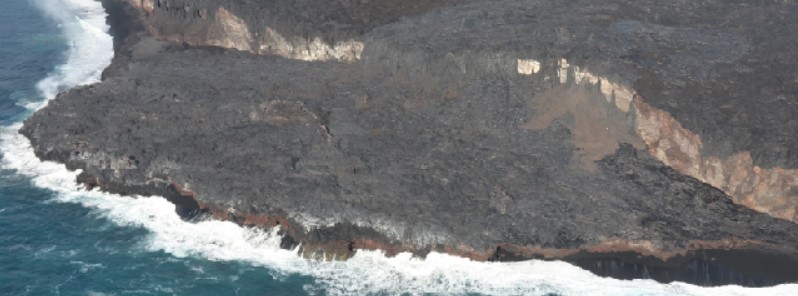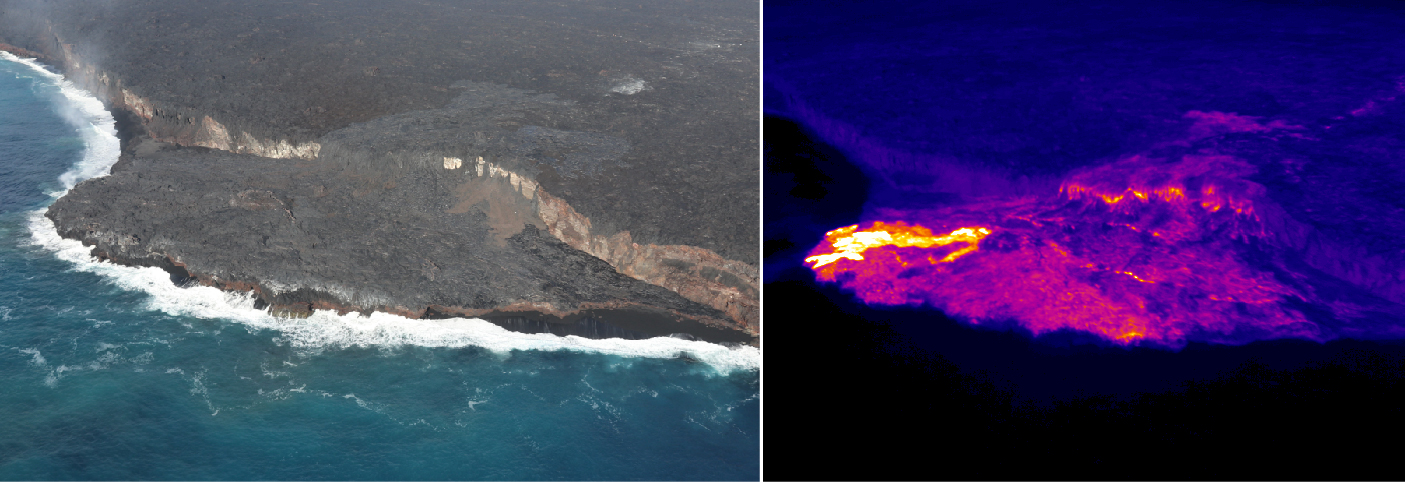Flowing lava continues to build a delta at Kamokuna, Kilauea, Hawaii

Kīlauea Volcano continues to erupt at its summit and from the Puʻu ʻŌʻō vent on its East Rift Zone, and the Kamokuna lava delta continues to grow.
As of November 1, 2017, the Kamokuna delta is roughly 4 ha (10 acres) in size. The ocean entry is fed by a surface flow on the delta, which is clearly seen in the thermal image (right) as a bright yellow color.
The thermal image also shows heat signatures from parallel cracks in the delta that were covered by lava flows during the past several months.

The ocean entry at the Kamokuna lava delta on November 1, 2017. The ocean entry was being fed by a surface flow on the delta, which is clearly seen in the thermal image (right) as a bright yellow color. The thermal image also shows heat signatures from parallel cracks in the delta that were covered by lava flows during the past several months. Based on the overflight, the delta is roughly 4 ha (10 acres) in size. The nearest surface flows on the coastal plain are about 1.4 km (0.9 miles) from the emergency road. Credit: USGS/HVO
The height of the lava lake at Kīlauea's summit was measured at 34 m (112 feet) below the rim of Overlook crater, HVO said November 9. Sulfur dioxide gas emission rates continue to be high but seismicity rates are at normal, background levels, with tremor fluctuations related to lava lake spattering.
The episode 61g flows do not pose a threat to nearby communities at this time. However, the ocean entry is a hazardous area.
Lava from the episode 61g flow continues to flow down the pali and onto the Kamokuna delta and webcam views indicate that scattered breakouts remain active above the pali and on the coastal plain. A new breakout occurred on the pali at 23:30 local time Wednesday, and continued Thursday morning.
Hazards
Ocean entry hazards include walking on uneven, glassy lava flow surfaces and around unstable, vertical sea cliffs. Venturing too close to an ocean entry on land or the ocean exposes you to flying debris from a sudden explosive interaction between lava and water. Also, the lava delta is unstable because it is built on unconsolidated lava fragments and sand. This loose material can easily be eroded away by surf, causing the new land to become unsupported and slide into the sea.
In several instances, such collapses have also incorporated parts of the older sea cliff. Additionally, the interaction of lava with the ocean creates a corrosive seawater plume laden with hydrochloric acid and fine volcanic particles that can irritate the skin, eyes, and lungs.
Featured image credit: USGS/HVO

Commenting rules and guidelines
We value the thoughts and opinions of our readers and welcome healthy discussions on our website. In order to maintain a respectful and positive community, we ask that all commenters follow these rules.